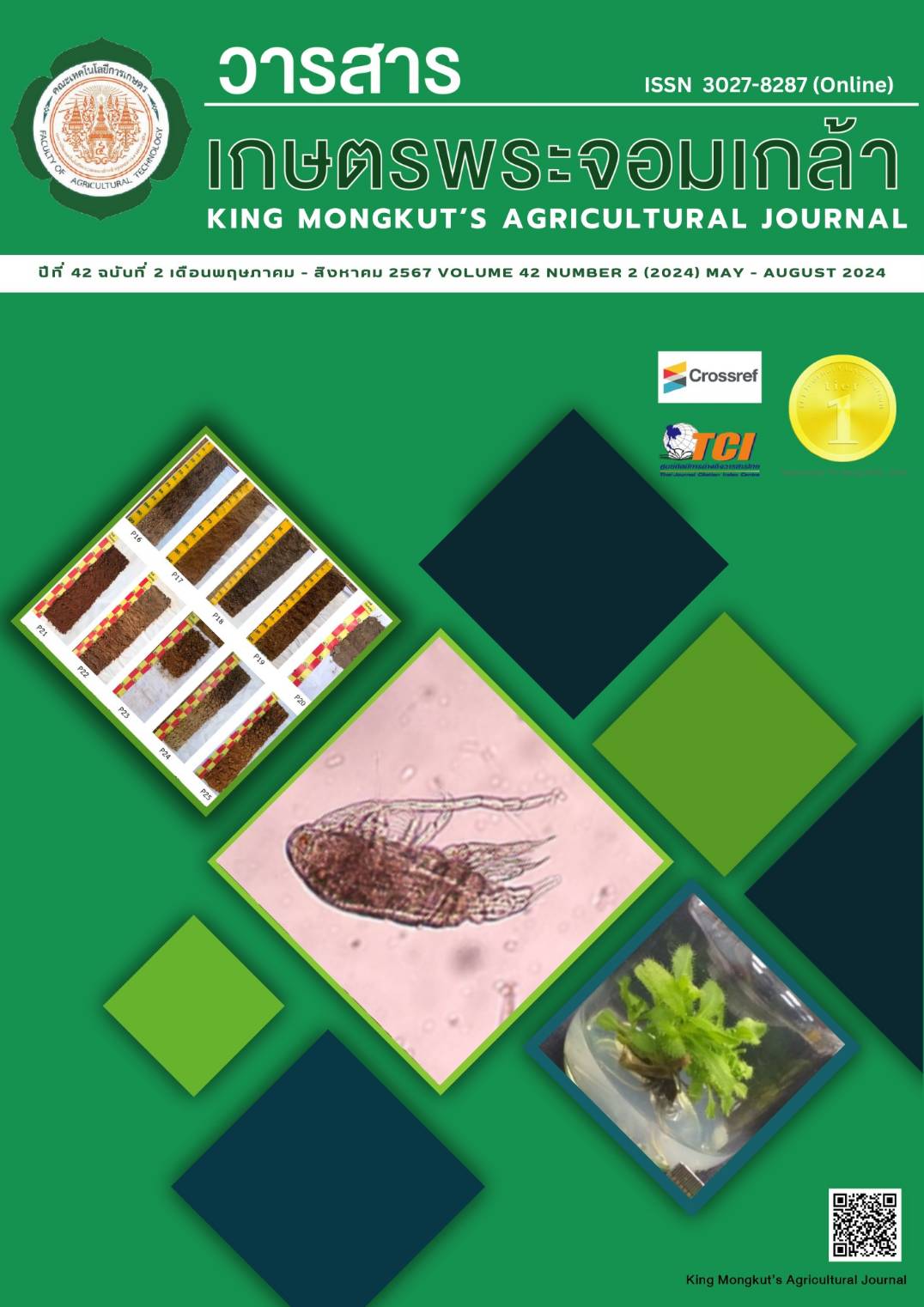Study on Lipid and Pigment Contents of Microalgae Cultivated in Water from Litopenaeus vannamei Shrimp Farm
Main Article Content
Abstract
This study aimed to cultivate microalgae in water from Litopenaeus vannamei shrimp farm to be used as supplement for shrimp. The study focused on its growth, lipid and pigment contents and effects of urea addition as nitrogen source and scale-up of microalgae cultivation. Microalga Chlorella sp. SHP isolated from shrimp farm showed higher pigment content and antioxidant activity than other two isolated strains. Chlorella sp. SHP grew best in effluent from treatment pond compared to water from reservoir pond and shrimp pond. The addition of urea at 2 g/L and the scale up in 50 L microalgae cultivation pond gave the maximum biomass of 0.19±0.03 g/L, the lipid content of 44.96±2.79%, and the contents of chlorophyll ab and carotenoids of 11.65 mg/g and 5.45 mg/g, respectively. The antioxidant activity based on radical scavenging activity of 1 g microalgal biomass was 66.71±0.02%. The findings from this study could be an alternative for producing microalgae with high lipid and pigment contents, and further utilization as low-cost supplements for shrimp cultivation.
Article Details

This work is licensed under a Creative Commons Attribution-NonCommercial-NoDerivatives 4.0 International License.
King Mongkut's Agricultural Journal
References
Bacellar Mendes, L. B., & Vermelho, A. B. (2013). Allelopathy as a potential strategy to improve microalgae cultivation. Biotechnology for Biofuels, 6, 152.
Bhalamurugan, G. L., Valerie, O., & Mark, L. (2018). Valuable bioproducts obtained from microalgal biomass and their commercial applications: A review. Environmental Engineering Research, 23(3), 229-241.
Brown, M. R., & Blackburn, S. I. (2013). Live Microalgae as Feeds in Aquaculture Hatcheries. In Allan, G., & G. Burnell, Advances in Aqua-culture Hatchery, pp. 117-157. Woodhead Publishing.
Chaoruangrit, L., Tapaneeyaworawong, P., Powtongsook, S., & Sanoamuang, L. (2018). Alternative microalgal diets for cultivation of the fairy shrimp Branchinella thailandensis (Branchiopoda: Anostraca). Aquaculture International, 26(1), 37-47.
Choochote, W., Suklampoo, L., & Ochaikul, D. (2014). Evaluation of antioxidant capacities of green microalgae. Journal of Applied Phycology, 26, 43-48.
Cichonski, J., & Chrzanowski, G. (2022). Microalgae as a source of valuable phenolic compounds and carotenoids. Molecules, 27(24), 8852.
Maneechote, W., & Cheirsilp, B., (2021). Stepwise-incremental physicochemical factors induced acclimation and tolerance in oleaginous microalgae to crucial outdoor stresses and improved properties as biodiesel feedstocks. Bioresource Technology, 328, 124850.
Markou, G., & Nerantzis, E. (2013). Microalgae for high-value compounds and biofuels production: a review with focus on cultivation under stress conditions. Biotechnology Advance, 31, 1532-1542.
Nasir, N. M., Jusoh, A., Harun, R., Ibrahim, N. N. L. N., Rasit, N., Ghani, W. A. W. A. K., & Kurniawan, S. B. (2023). Nutrient consumption of green microalgae, Chlorella sp. during the bioremediation of shrimp aquaculture wastewater. Algal Research, 72, 103110.
Poza-Carrión, C., Fernández-Valiente, E., Piñas, F. F., & Leganés, F. (2001). Acclimation of photosynthetic pigments and photosynthesis of the cyanobacterium Nostoc sp. strain UAM206 to combined fluctuations of irradiance, pH, and inorganic carbon availability. Journal of Plant Physiology, 158(11), 1455-1461.
Ruangsomboon, S. (2020). Microalgae Cultivation and Utilizations. Department of Fisheries Science, Faculty of Agricultural Technology, King Mongkut’s Institute of Technology Ladkrabang.
Safafar, H., Van Wagenen, J., Møller, P., & Jacobsen, C. (2015). Carotenoids, phenolic compounds and tocopherols contribute to the antioxidative properties of some microalgae species grown on industrial wastewater. Marine Drugs, 13(12), 7339-7356.
Yang, R., Wang, Q., Luo, X., & Wei, D. (2023) High-efficient nitrate conversion to protein and chlorophylls from synthetic wastewater by mixotrophic Chlorella pyrenoidosa. Algal Research, 71, 103025.


